The Cities of the Great Silk Road
| Tashkent Khiva Samarkand Bukhara Termez Fergana Valley |
Great Silk Road
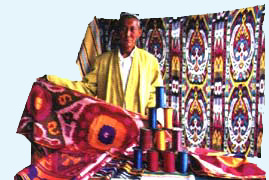 In the course of the 6-14th centuries, there were thousands of large and small routes that crossed the Asian Continent and lead to the West. Caravans stuffed with exotic cloths, eastern goods and spices followed these routes. Hence, the various centres of national crafts, art schools, madrassahs, palaces, mausoleums were also created. Traders, missionares and pilgrims travelled together on thouse routes bringing new religions, customs, goods such as glass, porcelain, soap, gunpowder, and most important ... Different culture. They were the ones who collected medicinal herbs, created the methods of curing diseases and investigated stars. In many ways for more than thousand year, the Great Silk Road linked many countries by peacefull activities such as trade, culture and spiritual exchange that is
In the course of the 6-14th centuries, there were thousands of large and small routes that crossed the Asian Continent and lead to the West. Caravans stuffed with exotic cloths, eastern goods and spices followed these routes. Hence, the various centres of national crafts, art schools, madrassahs, palaces, mausoleums were also created. Traders, missionares and pilgrims travelled together on thouse routes bringing new religions, customs, goods such as glass, porcelain, soap, gunpowder, and most important ... Different culture. They were the ones who collected medicinal herbs, created the methods of curing diseases and investigated stars. In many ways for more than thousand year, the Great Silk Road linked many countries by peacefull activities such as trade, culture and spiritual exchange that is
 unique to the whole mankind.
The Great Silk Road routes started from a town called Lanchjou and stretched to the cities of Tor and Sodom, both Mediterranean ports which acted as a
junction between East and West. This old East-West trading trail transplanted culture,
customs and religions from one center to the next, and vice-versa.
unique to the whole mankind.
The Great Silk Road routes started from a town called Lanchjou and stretched to the cities of Tor and Sodom, both Mediterranean ports which acted as a
junction between East and West. This old East-West trading trail transplanted culture,
customs and religions from one center to the next, and vice-versa.
Uzbekistan is the heart of the SilkRoad.
A special long-term program which includes a proposal on reviving the historical heritage was put together with UNESCO. The Samarkand Declaration "On revival of tourism on the Grea Silk Road" was adopted in Samarkand in 1994. Once again, the
Great Silk Road will revive for tourists and the magnificent architectural monuments,unique works of caligraphy, Chinese silks, Bukhara rugs and pottery produced by ancient craftsmen will stand to be appreciated ba all.
The main tourist route crosses 32 towns and cities of Central Asia. In other words, once the legendary Great Silk Road
reopens, crowds of tourists will also be visiting Tashkent, Samarkand, Bukhara, Khiva and the cities of Fergana Valley.
The Great Silk Road is one of the last oportunities to step into the world lost at thouse times. Travelling into the past and this spectacular passage is waiting for you to explore!
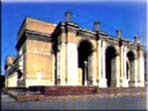
THE CITY'S HISTORY IS ROOTED IN HOARY ANTIQUITY, DATING BACK 2,000 YEARS. THE
RUINS ON THE MINGURYUK HILL AND THE SURVIVED FEUDAL CASTLES WITH MOATS, DOUBLE
FORTIFIED WALLS AND FORMIDABLE TOWERS WITNESS ITS GREAT AGE, THE UZBEK WORD
"TOSHKENT" MEANS A "STONE SETTLEMENT'. AS A MATTER OF FACT, THE CITY AROSE ON THE
SITE OF A VILLAGE WITH THE SAME NAME THAT LAYED AT THE CROSSING OF THE MOUNTAIN
ROUTES, AND PLAYED AN IMPORTANT ROLE IN EAST - WESTERN TRADE.
Tashkent
A Lifetime Of Memories And A Treasure
Of Friendships
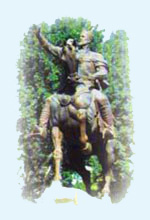   |
Over the twenty centuries of its existence, Tashkent witnessed quite a lot of major and minor events, and lived through the bloodshed wars and devastating invasions. Yet it always remained to be the hub for international trade, the center of a vast crop-growing oasis, the city of arts and crafts.
HISTORICAL MONUMENTS
Tashkent also served as a mighty fortress warding off the attacks of nomadic tribes.
The Kukeldash Madrassah, which also dates back to the 16th century, is a monumental structure with a tall gala portal and two robust minaret towers.
Over 9 years of independence of Uzbekistan, the capital has changed beyond recognition. Today, it is a truly a marvellous city with abundance of verdure and water. Numerous fountains adorn the city's squares, streets and parks. A major attractive place is the central part, where buildings, while paying tribute to national traditions, look perfectly up to date.
Chimgan
There is one of the popular mountain skiing resorts, Chimgan, in only 80 km drive from Tashkent, in Western Tyan-Shan mountains. Pure and fresh air, picturesque landscape, funiculars make Chimgan the best place for a good rest and sporting tourism. A modern hotel complex provides all kinds of services for tourists to make you spend an unforgettable time there. Mountain skiing and heli-skiing attracts fans of active sports from December till April.
CULTURE
While visiting Tashkent, please try to visit its famous theatres (e.g. Alisher Navoi Opera and Ballet Theatre). There are also some museums and exhibitions among the other attractions, which are worth seeing.
The Applied Arts Museum and the Museum of Arts of Uzbekistan introduce the visitors with old and contemporary samples of national art. The Uzbek capital is constantly getting younger and nicer. Its broad avenues and alleys, modern buildings of original design and well-appointed thorough fares make a harmonious view with the nice Metro stations.
While visiting the bazaars, stores, souvenir shops, museums or hospitable private houses you will have a chance to familiarize yourself with the traditional folk crafts noted for their superior artistry.

SAMARKAND IS ONE OF THE MOST ANCIENT CITIES
OF THE WORLD WITH A 2750-YEAR HISTORY, AND IS OF
THE SAME AGE AS ROME, ATHENS AND BABYLON. FROM
TIMES IMMEMORIAL, THIS CITY ATTRACTED THE
ATTENTION OF STATESMEN. MERCHANTS AND
TRAVELLERS. ITS MOST PROSPEROUS TIME WAS UNDER
THE RULE OF THE GREAT TEMUR. BORN IN SHAHRISABZ,
THE SAHIBKIRAN MADE SAMARKAND THE CAPITAL OF
HIS GREAT EMPIRE. SAMARKAND'S GEOGRAPHICAL
LOCATION WAS VERY CONVENIENT - AT CROSSROADS
ON THE GREAT SILK ROAD.
Samarkand
Famous For Ornate Architectures And Monuments That Offer A Poverful Experience Of
Bygone Grandeur
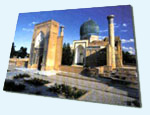   |
Examples of grandiose middle-aged architecture have been well preserved up to date.
The ensemble of mausoleums, known as Shahi-Zinda located near the settlement of
Afrosiab, is a fine example of Central Asian architecture. Its construction began
in the 12th century, and was completed in 14-15th centuries under the rule of
Temur. The burial vaults for the women of Amir Temur's family are the main
buildings of the ensemble. All the buildings are beautifully decorated with
mosaic, terracotta and majolica.
Registan is an ensemble of majestic majolica, azure mosaics and vast, well proportioned spaces. Guri Amir mausoleum (15th century). Temur, his two sons and two grandsons (including Ulugbek) lie here beneath the mausoleum. Above the crypts there is plain marble marker to the left of Temur's is that of Mirsaid Baraka - one of Temur's spiritual mentors. In frontal part, there is a grave of Muhammad Sultan, Temur's grandson through his son Jakhonghir, The stones behind Temur's mark there are graves of his sons Shah Rukh and Miran Shah. Behind those you can find the grave of Sheikh Umar, the most reverred Temur's teachers. The Guri Amir had been an inspiration for Taj Mahal in Agra.
Ulugbek, Temur's grandson, remained in the history as a "crowned scientist", the protector of science and enlightenment.
In 1420, when Ulugbek was ruling, there was built an observatory which is the one and only in the world. Formed "Zijji-Kuragoni" star tables preserved their scientific meaning up to date. The basement and a part of the astronomic instrument arc the only remainders of the observatory.
Under the auspice of UNESCO the 1225th anniversary of the outstanding scientist and theologists of the Orient Imam-Al-Bukhari was widely celebrated in 1997. The memorial complex in Khortang near Samarkand, where the great scientist was buried, has been reconstructed for his jubilee.
Samarkand opens its heart to the guests with its unique historical and architectural monuments, incomparable samples of handicrafts, customs and holidays as well as the secrets of Eastern cuisine.
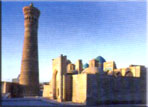
"BUKHORO- I-SHARIF" - "NOBLE", "HOLY" - IS SOME OF THE NUMEROUS EPITHETS THAT WERE
BESTOWED ON OUR ANCIENT CITY. THE GREAT EASTERN POETS OF THE 9-10TH C.C. RUDAKI,
DAKIKI AND FERDAUSI DEVOTED THEIR KASIDS TO IT. "THE HISTORY OF BUKHARA" HAD BEEN
ALREADY WRITTEN IN THE 10TH CENTURY. THE FIRST PERIOD OF BUKHARA'S LIFE FOUND ITS
REFLECTION IN FOLK EPOS, AND IN NUMBER OF LEGENDS.
Bukhara
Enchanting "OldCity" Charm That
Is Simply Mystical
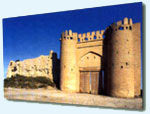  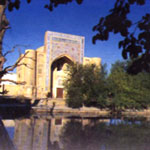 |
The Great Silk Road linking China with Iran, India with Europe also went through Bukhara. Bukhara is one of the ancient cities of Central Asia, contributed much in the development of human civilization. It is one of the cities, which was grown and has constantly been developing on the same place beginning with the 5th century B.C. In 1993 the historical part of Bukhara was included into the UNESCO List of Cities of world's human legacy.
In 1997 under UNESCO program there was celebrated the 2500th anniversary of Bukhara. The preserved architectural legacy of Bukhara is a rare combination of monuments of different times, emphasizing the development of people's architecture for as long as 25 centuries. Bukhara, with its millenium long history, is today's legacy of the mankind.
HISTORICAL MONUMENTS
Most of the Bukhara's central part is an architectural preserve, fail of former medressas. Ark - Royal Fortress (10th -19th centuries) is a museum. Opposite to Ark's gate, there is Bolo-Hauz Mosque beside the pool - the Emir's official place of worship, built in 1718, and probably was very beautiful at that time. Going up the narrow street, beside the Ark, one can sec a small square with the Poi-Kalon Complex, including the Kalon Mosque (16th century), which is big enough allowing 10,000 people to visit at a time, the Miri-Arab Madrassah - a working seminary dated back from 16th century and the Kalon Minaret, which is 47 metres high and 10 metres in depth. It is 850 years old and has never needed any cosmetic repairs. Labi-Hauz, a plaza was built around the pool back in 1620 and is the most peaceful and interesting spot in town-shaded by mulberry trees as old as the pool. It is crowded with the street merchants, old men crowded over the chessboards or gossiping tea. To the eastern side you can find Nadir Divanbegi Madrassah that was buill as a caravanserai, but Khan looked at it as a madrassah and in immediately reformed it as one in 1630. On the western side of the square he built the Nadir Divanbegi Khanako.
Right across the street on the northern side, there is a Kukcldash Madrassah, which was built by Abdullah II, and it was the biggest Islamic school in Central Asia at that time. The trade domes of 15-16th centuries witness the presence of Bukhara at the caravan criss-cross: Toki-Sarrafon (the dome of exchangers).
Toki-Telpak-Furushon (the dome of hat traders), Toki-Zargaron (the dome of jewelers), Tim Abdullahan.
On the way to Samarkand, in the suburbs of Bukhara, three km north from the center, you can find Sitorai-Mokhi-Hosa, which means 'Palace of Moon-like Slars {or Moon & Stars), the summer Palace of the last Emir Alim Khan (now a museum).
The Ensemble of Bakhauddin Nakshbandi is located in 12 km from Bukhara. This complex has been considered as the major holy place of Bukhara. Bakhauddin, in turn, has been considered as the most national Theologist of Bukhara.
...Palaces and mosques, mausoleums and minarets - the stone chronicle of Bukhara is surprisingly unique and the touch to its pages is
unforgettable.

WHILE VISITING KHOREZM EVERYBODY IS FASCINATED BY THE BEAUTY OF KHIVA, THE CITY
MUSEUM. THERE IS A LEGEND THAT IT WAS FOUNDED WHEN SHEM, SON OF NOAH, DISCOVERED
WEALTH AT THIS PLACE. HIS PEOPLE CALLED IT HEIVAK, FROM WHICH THE NAME OF KHIVA
IS SAID TO BE DERIVED.
Khiva
Stepping Back In Time To A Unique Era
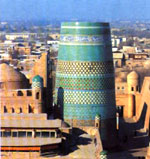 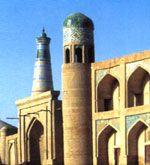 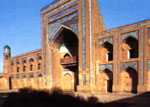 |
Khiva, one of the cradles of the world civilization, is also enlisted as a heritage of the human value. Once one of the important centres on the Great Silk Road, this city celebrated its 2500th anniversary in 1997. The anniversary was widely celebrated throughout the world. Khiva is always said to be the pearl of Khorezm oasis. It was fairly called this way due to accumulation of huge spiritual and cultural values. In the 9-12th centuries there were functioning major scientific centres of astronomy, mathematics, medicine, chemistry...The "House of wisdom" - the real academy of sciences, that was created by the Baghdad ruler Al-Mamun, was managed by the Khorezmi scientist Muhamm ad-Al -Khorezm iy. His fundamental works in mathematics, geography, geodesy had already been famous in Europe, and has not lost its importance and significance up to date. A huge scientific heritage was left by Al-Beruni, Agahi, Najmiddin Kubro and other scientists and divines.
The architectural monuments of the city of Khiva, which has fairly obtained the title of "city-museum", are also considered as a unique value of the world's legacy. The appearance of modern Khiva is mainly formed by the architecture of the Khiva Khanate, the end of 18 century the beginning of 20 century. The archcological excavations show that in the basement of the relatively "young" building ruins there were layers related to the 3d centuries B.C and earlier.
HISTORICAL MONUMENTS
ICHAN - KALA - According to the medieval architectural traditions, Khiva is divided into inner part Ichan-Qala, where it has about 60 historical monuments, and outer part Dishan - Qala, where the people of Khiva live and work. The Ichan-Qala nowadays is "an open air museum.'" Today's Khiva has been restored in the manner it was centuries ago. High and 2.5 km long mud walls surround the inner town with four gates pointing to four sides of the Universe.
KUHNA ARK - the Khiva rulers1 fortress and residence, first built in the 12th century by Aq Shibobo, then was expanded by the Khans in the 17th century. The Khan's harem, mint, stables, arsenal, barracks, mosque and jail were all at this place.
MUHAMMAD AMIN KHAN MADRASSAH & KALTA MINOR- the first building to the right inside the Western Gate was built in 1851-1852. It is the biggest madrassah in Khiva, having two stores of cells around the broad courtyard The facade of the building is decorated with brick mosaics. The entrance doors are presented with wood carving, and the windows have latticed decoration. Outside there is a wide, turquoise-titled Kalta-Minor Minaret that was built in 1853-1855. If they had had finished the construction it would have been a minaret higher than Kalon Minaret in Bukhara.

Termez
Kingdom of trade routes and brave warriors. The land whose wealth of gold and lazurite have astonished the world. Satraps of Baktria participating in ancient wars in the period of Mibia 8th c. B.C., as well as of Greece and Iran 6th c. B.C., participating in Darius and Kyarks military campaigns to Athens and Egypt in the 5th c. B.C. were obtaining high position in the persian army of Achamenids. Archeological findinfs prove that the age of the farming civilization here dates from the earlier period.
The early forms of culture revealed itself since ancient stone age epoch.
In the 4th c. B.C. Alexander the Great having defeated Darius ||| army incluided the Achamenids state and then Baktria to his Empire.
329-328 B.C. In Zariasp the capital of Baktria-the eparchy, embassadors of European skiffs, envoys of Horazm Tzar Farasman moved a proposal to Alexander of Macedonia on conclussion of alliance and frendship.
For more then 180 years Baktria was under the reign of Greeks and Macedonians. Baktria`s culture was absorbetd by elements of the Hellinism. Alexander of Macedonia tried to pursue policy of merging the Greek religion and the religion of local Gods.
312 B.C.-64 A.D. Period of the Selikvids` Pover with the collaps of Selikvids` state a new state- the Greek and Baktrian Kingdom sprang right on place of the Baktrian satrapy. Side by side with local religion Helenic Gods were worshiped. The Buddha study and Indian dicties that were sang of in hymns of a rigveda.
In the 3rd c.B.C. at the crossroads of India and China, new city of Termez sprang. Just here there was the Nephrite Route in the ancient time.
In the 2nd-1st c.c. B.C. Dakhya or later Tokharistan, one of the 3states in Central Asia, was founded at the ancient territory of Baktria.
1st-4th c.c. is the period of the Kushansa. At this time Buddhism was widely spread in the Eastern Turkestan and the Central Asia, in Termez particular.
There are large Buddhist complexes at Kara-tepa, Fayaz-tepa.
At the beginning of the 4th c. the Hephtals replaced the Kushans.
4th-5th c.c. is the Sasanids epoch.
6th-7th c.c. Turk Kogonate reign.
In the 8th c. Baktria, along with Termez, made a part of the Arab Caliphate.
9th-10th c.c. period of the Samanids reign.
11th-12th c.c. in the epoche of the Karakhanids and the Seljukids, feudal relations in Central Asia Advanced in development.
8th c.the Mongol (Jenghiz-Khan) invasion.
14th-15th c.c. The Temurids reign. Termez was considered as one of the main cities situated on the Great Silk Route.
In the 19th c. Termez became the main frontier city on the Russian southern border. Termez, the city with a centry -old history, now is one of the main economical centres of
Uzbekistan.
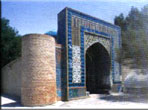
IT'S A GREEN VALLEY AND ONE OF THE CENTRAL ASIA'S BIGGEST OASES ON THE TERJUTORY OF 22 000 SQ. KM., WITH POPULATION OF 7 MLN PEOPLE. SURROUNDED BY TIEN SHAN MOUNTAIN RANGE AND DRAINED BY UPPER SYR-DARYA AND NARYN, THE CLIMATE AND FERTILE SOIL ARE IDEAL FOR CULTIVATION.
Ferghana Valley
A Valley Of Enchantment With Beautiful Mountainous Countryside Views
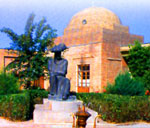  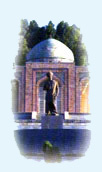 |
Ferghana Valley is well known for its gorgeous and ancient cities as Andijon, Ferghana, Quqon, Marghilon, Shohimardon and other cities that complement the beauty and significance of the Valley.
Surrounded by high mountains and hills, Andijon is situated in the south-east of Farghona valley. Andijon and Olamyshik hill are rich of oil, gas, spring waters and other natural resources.
Andijan is one of the ancient cities of Uzbekistan with the history dating back to 9th century A.D.. It is one of the industrial centers of Uzbekistan. Since obtaining the independence of a Uzbekistan (1991) the Uzbek-Korean Joint Venture "UzDaewoo" automobile assembling plant was constructed in Assaka.
Andijon is situated on the caravan route linking China with Central Asia. In ancient times the Great Silk Route passed via this town, which was known as the eastern gate to Ferghana Valley. All along the Route on the banks of Kara-Darya river, there were caravanserais with blacksmiths ready to render their services to merchants. New settlements and towns started springing up here; thus new handicrafts started developing.
Quqon had been the capital of Quqon Khanate in 18th and
19th centuries and also traditionally the religious center of the Valley,
having 35 madrassahs, and hundreds of mosques.
Marghilon was a carpet making centre in ancient times, defined by its architectural traditions. Caravans with silk went from Marghilon to Arabia. Today silk mills produce 20 mln meters of silk. It is located near Shohimardon. one of the favourite mountainous places in Uzbekistan. Kuva is a memorial site of the scientist Al-Ferghaniy, who lived and was famous in Europe under the name Alfraghanus.
Namanghan region is located in the northern part of the Ferghana
Valley, on the right bank of Syr-Darya river. The plain merges in
the north with the foothills of northern Chatkal and the Quramin
ranges in 25 km drive from Namanghan, in the north of Ferghana Valley,
there is an archaeological site of an ancient settlement Akhsikent.
This settlement was destroyed by the earthquake in the 17th century,
and had never been rebuilt. The
tourist route goes through the picturesque places: on the upper side,
there is a highland stream Podshoh-Ota, Kapchiug canyon, mountain
lakes, Alpine meadows at an altitude of 1925 metres above the sea
level, and Sary-Chelck nature preserve.
Ferghana Valley today, like some other regions of Uzbekistan, has a developed agriculture, especially in cotton industry. A lot of fruits and vegetables are grown here. Ferghana is the main supplier of silk cocoons and is the second after Marghilon on raw silk production. Ferghana is also known as "The Pearl of Uzbekistan".
![]()